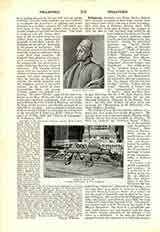

Pollajuolo, ANTONIO AND PIERO BENCI, derived their surname, according to Florentine custom, from the trade of their father, who was a dealer in poultry. Both were born at Florence, Antonio about 1432, Piero in 1443; both died in Rome, the younger in 1496, the elder in 1498, and both were buried in the same tomb in San Pietro in Vincoli. Antonio studied painting under Uccello, and was influenced by Baldovinetti. Among his individual paintings are: “David” (Berlin Museum); “Fight of Hercules with Antwus”, “Fight of Hercules with the Hydra”, two small panels (Uffizi); “Hercules and Nessus” (Jarves collection, New Haven, Conn.); “Communion of Mary Magdalen” (Pieve de Staggia, near Poggibonsi). The collaboration of the brothers began in 1465. Piero, brought up in his brother’s studio, received lessons from Castagno, Uccello, and Baldovinetti. He painted the altar piece representing “Sts. James, Vincent, and Eustachius” (Uffizi); “Tobias and the Angel” (Museum of Turin); and the “Annunciation” (Museum of Berlin). Both brothers drew designs depicting the life of St. John Baptist, from which were made the embroideries for the San Giovanni baptistery (Museum of the Duomo, Florence). In 1475 they finished the altar piece representing the “Martyrdom of St. Sebastian” (National Gallery, London).
The Pollajuoli were likewise portrait painters of renown, but these works have nearly all perished. The portrait of the wife of Giovanni Bardi (Museum Poldi-Pezzoli, Milan) has been ascribed to Antonio. To Piero are credited: the “Galeazzo Sforza” (Uffizi), six of the cardinal and theological “Virtues” (Mercanzia of Florence, 1469), sitting in marble niches, with mosaic ornamentation, and characterized by nobility and gravity, and the “Coronation of the Virgin” (Church of San Gimignano, 1483), a mediocre altar piece.
Antonio was chiefly a goldsmith and sculptor. As a goldsmith he worked in the studio of Ghiberti. His two masterpieces in the Baptistery are the bas-relief of the “Nativity” (Museum of the Duomo), and the large silver cross which he executed in collaboration with Betto di Francesco Betti. As a sculptor he was the pupil of Donatello and excelled in the treatment of bronze. He executed the small group of “Hercules and Cacus”, several busts, and (1493) the tomb of Sixtus IV, ordered by Innocent VIII. This magnificent bronze tomb is in St. Peter’s, in the chapel of the Blessed Sacrament. The head is a remarkable portrait, made from a cast and crowned with the tiara, on which Antonio expended all the delicacy of his talent as a goldsmith. At the sides the liberal andprospective arts are represented as half-nude women, refined and elegant, but pagan. The monument to Innocent VIII at St. Peter’s was also executed by Pollajuolo. In the lower part the pope is represented as dead, while above he is depicted as in life, seated on his throne and giving his blessing. The ornamental female figures of Virtues are charming but profane. Antonio Pollajuolo also carried his passion for anatomy and the nude into painting, even in religious pictures such as the “Martyrdom of St. Sebastian”, where it is quite offensive. He was “the first of those great pagan artists of the Italian Renaissance for whom the human form, living or dead, and the study of anatomy and the nude became the sole aim and irresistible passion” (A. Perate).
GASTON SORTAIS

